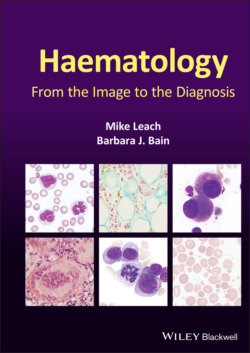Читать книгу Haematology - Barbara J. Bain, Irene Roberts - Страница 23
Оглавление14 Septicaemia
A 5‐year‐old girl was admitted as an emergency after a collapse following a fever at home. On assessment she was acutely unwell and hypotensive and had generalised petechiae. The clinical picture was of severe sepsis and after blood cultures had been taken she was commenced on broad‐spectrum antibiotics. The full blood count showed Hb 120 g/l, WBC 20 × 109/l, neutrophils 17 × 109/l and platelets 32 × 109/l. The coagulation profile was indicative of disseminated intravascular coagulation (DIC). The blood film (left images ×100 objective) showed neutrophilia with left shift; in particular there was prominent neutrophil vacuolation and there were cytoplasmic inclusions consistent with the appearance of diplococci. Note also the prominent Döhle bodies in the neutrophils (bottom left). Meningococcal septicaemia now seemed likely and was confirmed on blood cultures and PCR studies.
A second patient, a 62‐year‐old man, was admitted following a collapse after a 2‐day prodrome of feeling non‐specifically unwell. He had been bitten on the hand by a dog some days previously. He was febrile and hypotensive and had widespread petechiae. His condition deteriorated and he required intubation, ventilation and inotropic support. His full blood count showed Hb 137 g/l, WBC 24.2 × 109/l, neutrophils 22.7 × 109/l and platelets 9 × 109/l. The coagulation screen was again indicative of DIC (PT 25 s, APTT 92 s, TT 17 s, fibrinogen 1.5 g/l and D dimer 88 726 ng/ml). The blood film showed neutrophilia with left shift and some neutrophils had rod‐shaped bacterial inclusions (centre images). Blood cultures grew the Gram‐negative bacillus, Capnocytophaga canimorsus, which is a serious human pathogen that often forms part of normal canine and feline flora.
A third patient, a 66‐year‐old woman was in hospital with obstructive jaundice due to liver metastases from ovarian carcinoma and had external biliary stents in situ. She was receiving weekly paclitaxel chemotherapy. She became acutely unwell, developing hypotension and jaundice. The full blood count showed Hb 57 g/l, WBC 7.3 × 109/l and platelets 177 × 109/l. As in the previous cases, the blood film was informative; it showed profound red cell spherocytosis (right images) with red cell ghosts (top right image) and toxic granulation of neutrophils (bottom right image) but no bacterial inclusions were seen. Despite resuscitation efforts the patient died shortly afterwards. Blood cultures subsequently grew Clostridium perfringens. This bacterium can be a commensal of the normal hepatobiliary and gastrointestinal tracts but becomes a serious and life‐threatening pathogen when it gains access to the blood, most likely in this case in relation to the stent. It produces an alpha lecithinase enzyme which directly lyses the red cell membrane, inducing an acute haemolytic anaemia that further compounds the septicaemia. The blood film features are typical of this condition; the spherocytes are due to membrane perforation, as are the ghost cells where all red cell haemoglobin has been leaked. By the time the blood film has been assessed, most affected patients have succumbed to this form of septicaemia but in some cases the morphological features may indicate the need for rapid active management and save a life.
MCQ
1 Neutrophil vacuolation can be a feature of:Bacterial infectionChédiak–Higashi syndromeEthanol toxicityNeonatal necrotising enterocolitisNeutral lipid storage diseaseFor answers and discussion, see page 206.
